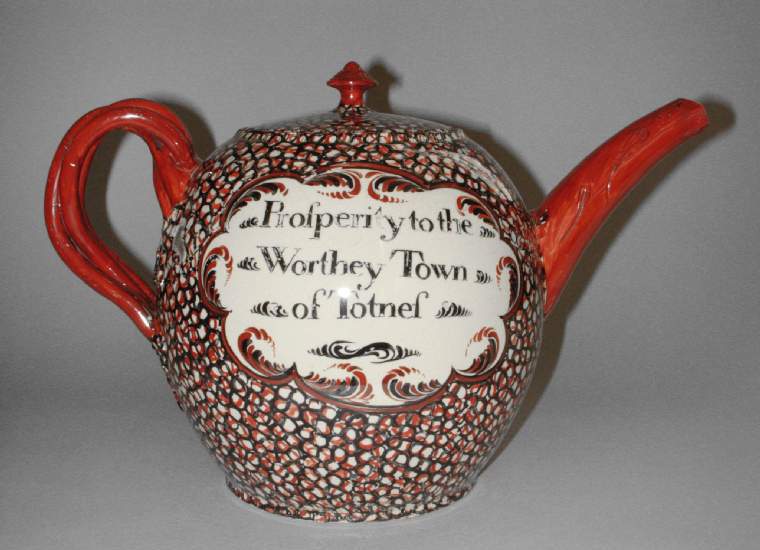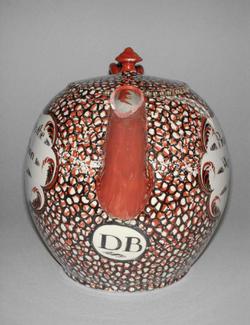Current Location: Gallery 27 (Glaisher)
Maker(s)
Pottery:
Indio Pottery
(Probably)
Pottery:
Unidentified Yorkshire or Staffordshire Pottery
(Possibly)
Entities
Categories
Description
Dark cream earthenware, lead-glazed, and painted in reddish-brown and black enamel, and inscribed ‘Prosperity to the Worthey Town of Totnes’, initialled 'DB' and dated '1768'
Dark cream earthenware, the body thrown, with an applied spout, and handle with press-moulded terminals, lead-glazed and painted in reddish-brown and black enamels, and gilt on the edges (mostly worn away). The pot has a bulbous oval body with a slightly projecting lower edge, a curved upward tilting spout with two curved lines incised on each side, and a double entwined handle with upper and lower flower and leaf terminals. The edge of the base and the mouth are encircled by a rouletted band of closely-set short lines. There are twenty-five holes in an asymmetrical arrangement in the wall behind the spout. The circular cover is very slightly convex with a rouletted edge to match the pot, and has a knob with capstan-shaped lower part and a stepped and domed top with a central boss. On each side of the pot there is an oval panel with a scalloped and scrolled edge enclosing the inscription 'Prosperity to the/Worthey Town /of Totnes', painted in black. Below the handle there is a scalloped oval panel enclosing the date '1768', and under the spout, a circular medallion enclosing the initials 'DB'. The rest of the surface of the pot and its cover are decorated overall with a reddish-brown and black scale or pebbled pattern. The handle, spout and knob are reddish-brown, and the rouletted edges bear traces of gilding.
Notes
History note: Mr Stewart Acton, Brighton from whom purchased on 13 September 1924 for £7.10s.0d. by Dr J.W.L. Glaisher, FRS, Trinity College, Cambridge
Legal notes
Dr J.W.L. Glaisher Bequest
Measurements and weight
Height: 24.7 cm
Length: 39.5 cm
Acquisition and important dates
Method of acquisition: Bequeathed
(1928-12-07)
by
Glaisher, J. W. L., Dr
Dating
18th Century, third quarter
George III
Production date:
dated
AD 1768
Note
Punch pots are much less common than punch bowls, and do not appear to have been made before the second half of the 18th century. They look like giant teapots, but their use for punch is evidenced by a Liverpool porcelain punch pot made by Seth or John Pennington's factory, c. 1780-90, and decorated with an outdoor social gathering in which a punch pot can be seen on a table. A pot of this size would have looked extremely out of place on a drawing room tea table. Tea was heavily taxed and teapots were usually small. Some punch pots are distinguishable from teapots by their decoration. For example, an enamelled salt-glazed stoneware example of c. 1760 in the Potteries Museum, Hanley (inv. no. 2287,1164), is decorated with Bacchus seated astride a barrel, indicating its use for alcoholic liquor. A few of the pots are distinguishable from teapots in not having a group of small holes behind the spout to emit the tea, but inhibit the flow of tea leaves. However, that is not always the case. This pot has twenty-five holes, but its large size, indicates that it was probably intended for punch.
Punch probably took its name from the Urdu, panch, meaning five. Punch recipes often included five ingredi¬ents: an alco¬holic liquor (usually red wine, brandy or rum), lemon, spices, sugar and hot water. It was enjoyed by English mer¬chants in the East by the 1630s, but was not widely known in England until Charles II's reign (1660-85). Punch soon became popular with all classes of society and rem¬ained so until the nineteenth century. Recipes for it can be seen in many published and hand-written recipe books of that period. Both men and women drank it, but the typical punch party was an male gathering.
When Dr J.W.L. Glaisher bought this punch pot he thought it had characteristics of Leeds Pottery, but was aware that the date was before the founding of the pottery. Given the inscription, it seems possible that the pot was made at Bovey Tracey in Devon, but the attribution is not conclusive because the date is early for creamware made there. The initials DB may stand for Daniel Barstowe who was a burgess or freeman of the Borough of Totnes.
School or Style
Rococo
People, subjects and objects depicted
Components of the work
Decoration
composed of
enamel
( reddish-brown and black)
gold
Body
Decorfation
Materials used in production
dark cream
Earthenware
Lead-glaze
Techniques used in production
Lead-glazing
Inscription or legends present
- Text: Prosperity to the/WortheyTown/of Totnes
- Location: On both sides of pot
- Method of creation: Painted in black enamel
- Type: Inscription
Inscription present: within an circular outline
- Text: DB
- Location: Under spout
- Method of creation: Painted in black enamel
- Type: Initials
Inscription present: within a scalloped oval outline
- Text: 1768
- Location: Under handle
- Method of creation: Painted in black enamel
- Type: Date
References and bibliographic entries
Related exhibitions
Identification numbers
Accession number: C.1051 & A-1928
Primary reference Number: 71230
Old object number: 4437
Stable URI
Audit data
Created: Saturday 6 August 2011
Updated: Tuesday 30 April 2024
Last processed: Thursday 14 August 2025
Associated departments & institutions
Owner or interested party:
The Fitzwilliam Museum
Associated department:
Applied Arts







